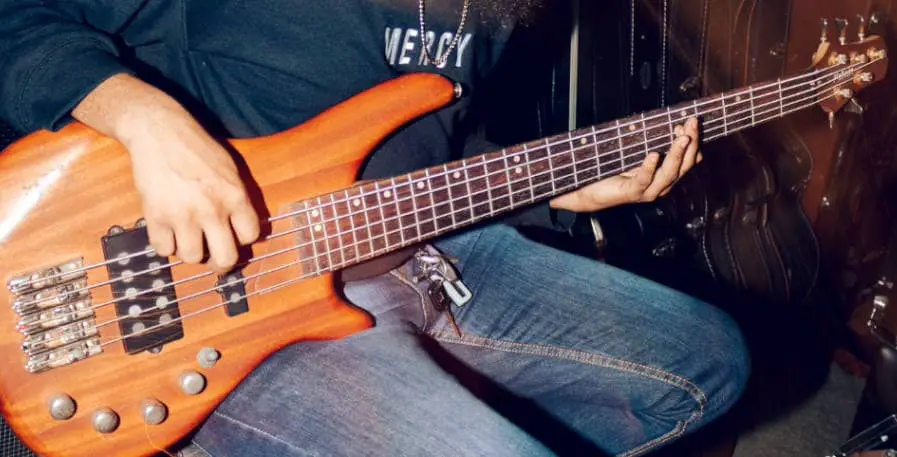Learning to play the 5-string bass is often made out to be more complicated than it has to be.
However, there are some differences when it comes to learning the 4 and 5-string bass as a beginner. While these differences are minor, knowing about them is useful for learning the instrument as efficiently as possible.
When I picked up a 5-string for the first time to play in a melodic death metal band, I approached the instrument all wrong.
I thought you needed a 5-string bass for metal and didn`t weigh the pros and cons of 4 and 5-strings. I focused on practicing all the wrong things and did not consider the strengths and weaknesses of my instrument. As a result, my progress was a lot low slower than it needed to be.
Therefore, I decided to write this article so you won`t have to make the same mistakes I did.
I`ll show you whether 5-strings are good for beginners and whether they are a harder instrument to learn. Then, I`ll show you how to learn the 5-string bass the right way. Lastly, I`ll show you what scales to practice on the 5-string and leave you with some fun and beginner-friendly 5-strings songs to try out.
Are 5 string basses good for beginners?
In general, 5-string basses are good beginner instruments. The low B string makes it easier for beginners to play in deeper tunings than tuning down and setting up a 4-string bass. As the neck of the 5-string is wider than a 4-string, it can however be a more cumbersome instrument for young bassists.
Playing songs in lower tunings is easier for beginners on a 5-string than on a 4-string. This is because tuning down a 4-string more than a whole step generally requires you to get new strings and a bass setup.
For a beginner, this can be somewhat overwhelming as you need to take multiple steps to even start playing. 5-string players on the other hand can just plug in and play. Depending on what tuning a song is written in, it might however need to be transposed to make it easier to play on the 5-string.
5-String basses also have wider necks than 4-strings. How much the wider neck will impact your playing largely comes down to your physiology. Grown bassists with bigger hands will generally not struggle with this. Younger players and bassists with small hands on the other hand are more likely to find a 5-string bass more cumbersome to play.
4-String basses vary more in neck width than 5-strings, but are generally between 38mm (1.49″) and 43mm (1.69″). 5-strings are usually about 44mm (1.73″), with some models being slightly wider.
I have never seen the width of the neck make a 5-string unplayable for someone. If you want to play a 5-string, neck width should thus not stop you from doing so. However, bassists on the smaller might find a short-scale bass with a 5-strings, or a 4-string to be more comfortable.

Is it harder to learn 5-string bass?
Compared to the 4-string, the 5-string bass is slightly harder to play. This is because there is an additional string to keep muted and controlled. Given that 5-strings have wider necks than 4-string basses, they can also be more demanding on your hands.
Keep in mind though that this increase in difficulty is minor. While keeping an extra string muted takes some additional practice, it will thus not greatly increase the difficulty of learning to play a 5-string.
The B standard tuning of 5-string basses also maintains the same perfect fourth interval between strings as the 4-string. Thus scale patterns will always repeat across the strings, even if you have 1 more of them. This means that any scale or finger pattern that can be played on the 4-string, can easily be adapted to the 5-string.
The same goes for keeping strings muted. Playing the E-string cleanly can be harder on a 5-string than on a 4-string because you need to keep the B string muted. This also makes it slightly harder to slap a 5-string bass than a 4-string.
Learning to keep strings muted is a skill you need to master on both the 4 and 5-string. However, the E string is played frequently, and an unmuted B string can be very intrusive to your tone. Improper muting is thus generally more detrimental to your sound on a 5-string.
Therefore, I recommend emphasizing proper muting and producing a clean tone when starting out with the 5-string.
Aside from that, learning the 5-string is similar to learning a 4-string bass. You have an additional string to keep track of, but in return, you have a deeper range and a lot more melodic options.
5 String Bass scales
There are two scales that you should always focus on learning first: The major and minor scales. This is because these two scales are used in the vast majority of western music.
A scale always has the same pattern on the 5-string fretboard. Thus, you could benefit from checking out this chart of 5-string bass notes if you are unsure about where to find specific notes.
As an example, here is a B major scale spanning two octaves on a 5-string bass:


If you can memorize this pattern, you will know how to play every major scale on the 5-string. If you play the same pattern at a different spot on the neck it will still be a major scale but in a different key.
As an example, let`s move the pattern 6 frets up the neck. This gives us an F Major scale, which looks like this:


The same principle can also be applied to the minor scale. As long as you know the pattern of the scale, you can play it in any key. Here is the finger pattern for the B minor scale on a 5-string:


If you can remember this pattern you will also know every minor scale. Let`s try moving it up 2 whole steps this time around, which gives us a D# minor scale:


To start with, I recommend practicing the major and minor scales until you know them like the back of your hand. The vast majority of songs you will learn will be written in one of these two scales. If you are looking to write music, they will also be essential tools for constructing your own basslines.
The best way to do this is to get comfortable playing these two patterns at different parts of the fretboard. I recommend practicing them regularly until you can play them anywhere on the neck.
When you get comfortable doing that, try starting the scale on a different spot than the root note. For example, when playing a B major scale, try beginning on the F# and see if you can play the B major scale up and down from there.
It will take some time to get comfortable doing this. However, dedicating 15-30 minutes of practice every day to playing scales is one of the best ways to improve when starting out with the 5-string. I can tell you from experience that it will be worth it.

Beginner 5-string bass songs
One of the best, and most fun ways to familiarize yourself with the 5-string bass is to cover some songs. I have made a list 5 string bass tabs that make use of the B string, where you will find songs for various skill levels.
For some easy songs to start out with though, I recommend these 3 beginner-friendly 5-string bass tabs:
1. MGMT – Kids
“Kids” is not only a great song for learning the 5-string. It will also teach you how to play octaves, which is an essential skill for any bass player. It`s not hard, but it will test your fingers` stamina if you are unfamiliar with this style of playing.
The song can be played both with a pick or with your fingers, and is also a great choice if you want to try slapping. It`s a catchy and fun line and a great groove for making use of both the low and high range of your 5-string bass as a beginner.
2. Bon Jovi – It`s My Life
You know those low hits at the beginning of “It`s My Life” that make people go crazy at karaoke bars? That`s the sound of a 5-string bass, which shows just how impactful those deep notes can be.
This song has a tempo of 120 BPM and mainly consists of quarter notes. It has some melodic elements to it, but the finger patterns for these are on the easier side. This in combination with the slow speed of the song makes it great for beginners.
3. Skillet – Monster
For a heavier 5-string song, try out “Monster” by Skillet. Since it`s hard to sing and play bass at the same time, John Copper tends to keep his basslines simplistic and heavy. This makes for songs that are great for beginners to learn.
It has a groovy but simple main riff and plays a straightforward 8th note groove for the chorus. As a result, this song is easy, but also a lot of fun.
Conclusion
As you can tell by now, learning the 5-string bass is not all that different from learning to play a 4-string. Learning to play the bass well is difficult for a multitude of reasons, and playing a 5-string only bumps the difficulty up very slightly.
The main differences between the 4 and 5-string are the neck width and frequency range. The extra string on the 5-string also makes muting and slapping feel different from the 4-string. For these reasons, it`s best to focus on proper muting and producing a clean tone when learning the 5-string.
Scales follow the same patterns on 4 and 5-string basses in standard tuning. Thus, any finger patterns for the 4-string can be applied to the 5-string as well. I recommend making use of every string on your 5-string when practicing scales, as this will build better control and mastery of the fretboard.
The reason most basses have 4-strings is that it was modeled after the double bass. As music has evolved, and deeper tunings have become more commonplace over the years, it has become more common for bassists to play 5-strings. Thus, if you want more melodic options and a deeper range, playing a 5-string will suit you well.

